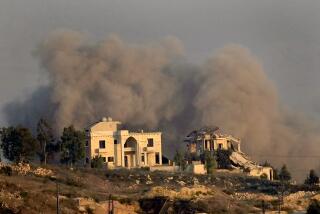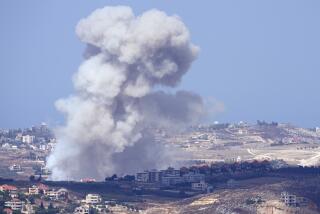1983 Beirut Blast Killed 241 : U.S. Traces Bomber, Gear in Marine Barracks Attack
WASHINGTON — Five years ago today, at 6:22 on a balmy Sunday morning, Lt. Joe Golebiowski was making breakfast tea on the perimeter of the Marine position at Beirut’s International Airport when a deafening explosion nearly blew him off his feet.
Grabbing his binoculars, the young platoon commander searched for the target. Then he realized he was looking at a building he had been unable to see before.
The Marine battalion headquarters had always stood in the way.
The bombing of the massive four-story compound, housing part of the U.S. peacekeeping force in Lebanon in the aftermath of the 1982 Israeli invasion, killed 241 Marine, Navy and Army personnel.
Never had so many Americans died in a terrorist attack, and not since Iwo Jima in 1945 had so many Marines died at one time.
From the rubble, however, the combined resources of the departments of State, Justice and Defense and the CIA have assembled clues identifying the forces behind what the FBI said was the largest man-made, non-nuclear explosion since World War II.
Among the tons of steel and concrete debris, for example, was a bit of an axle, the only trace left of the nine-ton truck driven into the barracks. After three years of intensive forensic work, the FBI traced the truck to a Mercedes-Benz assembly plant in Iran.
“They even found out that the engine had been rebuilt,” a former Pentagon official said.
With even less to go on, investigators also determined that the sophisticated explosive device originated in Bulgaria and reached Beirut by way of Syria. They said individuals within Syrian President Hafez Assad’s labyrinthine intelligence network were involved.
The device was equivalent to nine tons of dynamite, 50% larger than originally estimated. Made of a sophisticated explosive enhanced by gas, it was only the size of an unfolded card table.
‘Smiling Death’
Perhaps most interesting was the identity of the suicide driver, later nicknamed “Smiling Death” by Marines because a sentry recalled being chilled by the expression on the bomber’s face as he raced his Mercedes truck toward the building full of sleeping Marines.
Although the bomber was “blown to dust,” as a Marine survivor told reporters that day, U.S. intelligence determined his identity and assembled a profile of his life. The most deadly terrorist attack on Americans was carried out, according to Reagan Administration sources, by a “young nobody” who had no criminal record.
One counterterrorism specialist described him as a devout Lebanese Shia Muslim, “a kid seduced by the politics of Hezbollah,” the extremist Party of God. Another called him an impressionable youth who came from a poor, religious family.
The sources declined to provide a name. But the profile fits many of the Shia suicide bombers of other American targets whose names are also now in the hands of U.S. law enforcement officials.
Handpicked by the Lebanese militia for a specialized mission, he was trained by Iran’s Revolutionary Guards. Counterterrorism sources said that the chain of command included Imad Mughniyah, the Islamic Jihad (Islamic Holy War) leader also held responsible for the abduction of at least six Americans and five Frenchmen since 1984.
Despite all of the information gathered by U.S. intelligence, officials do not expect to indict anyone for the bombing.
“There’s a big difference between intelligence and evidence,” said Alvin P. Adams of the State Department’s counterterrorism office. “And it’s very hard to meet the high standards of evidence in this country.”
U.S. officials believe that the bomber himself did not know his specific assignment until immediately before his mission. “The immediate psychological buildup that drove him to a pitch of readiness was a short time frame,” one said. “It all happened very quickly.”
What officials may never know is whether he intended to commit suicide. Intelligence work following the bombing of the U.S. Embassy in Beirut six months earlier indicated that the driver had intended to park and escape, but the bomb in his van was detonated by remote control just as he turned into the embassy’s entrance.
The Marine bomber’s family, U.S. intelligence determined, later received money, presumably from Hezbollah. Some U.S. sources read the funds as a payoff, while others point out that Shia tradition calls for financial aid to the families of “martyrs.”
If the Marine bomber was truly on a suicide mission, some U.S. specialists regard him as an exception to the rule in the Middle East. “Even in some incidents where it appears that there was preparation for suicide, the terrorists don’t follow through,” an FBI official said.
The State Department’s Adams added: “As a general rule, we haven’t seen suicide bombings outside of Hezbollah. These terrorists like to live.”
Hijacking Recalled
One expert cited the hijacking last spring of Kuwait Airways Flight 422 as a case in point. “They wired the plane up,” he said, “but they brought changes of clothes and used different accents and different languages, all to the end that they were going to get out of this alive and didn’t want to be identified.” The plane was diverted to Cyprus and then Algeria, where the hijackers negotiated their freedom in exchange for the hostages.
Yet the record in the Middle East since the Marine barracks bombing also shows more than a dozen suicide bombings. More than half were carried out by secular groups that adopted the tactic after it was proven successful against the U.S. Embassy and the Marine barracks.
At almost the same moment as the Marine barracks bombing, another suicide bomb attack leveled a French paratroop barracks 2 miles away, killing 58.
One of the most chilling and clearly premeditated cases involved a young woman belonging to a secular pro-Syrian party. Sana Mheidleh, 16, videotaped a will that was later shown on Lebanese television outlining her intentions and her last wishes before driving into an Israeli checkpoint in Lebanon in 1985, killing two Israelis.
Recent Attack
And, although suicide attacks have decreased over the last two years, their potential was driven home last Wednesday when a suicide driver rammed into an Israeli army convoy near the Israeli-Lebanese border. Seven Israeli soldiers were killed instantly and 11 people were injured. An eighth soldier died Saturday of wounds suffered in the blast.
Five years after the Marine barracks bombing, controversy still swirls around the conduct of the U.S. peacekeeping mission in Lebanon.
Although supporters of the operation believe that the Marine compound afforded protection from the likeliest dangers--sniper fire and artillery assault--critics charge that too many U.S. servicemen were concentrated in a single building in an exposed position on the Beirut airport’s periphery. And the Marines were not allowed to lock and load their weapons unless otherwise instructed.
More than that, the American troops had been drawn into participating in clashes that were breaking out at an increasing rate in Beirut. In October, 1983, they were no longer considered neutral monitors of Lebanon’s fragile peace.
Yet top officials at the time still insist that the same thing could happen again.
Concerned About Security
“If you put a group of military men in a static situation, and, in effect, the standing rules prevent them from taking normal actions to ensure their safety, you’d get the same result,” former Marine Commandant Gen. Paul X. Kelley, who reportedly may have lost his chance to become chairman of the Joint Chiefs of Staff because of the bombing, said.
“There is no way you can keep your guard up forever,” he added. “My concern is that we wax and wane in this country on security. After five years, we’re seduced again that it’s not a big threat. Someone may zap us again.”
In the last five years, service personnel and diplomats have received better training in security and counterterrorism, and barriers and traps have been placed not only around U.S. embassies and military bases abroad but also in front of the White House and other potential terrorist targets in the United States.
But no one in the government is predicting that these measures will prove sufficient.
“There is no sure defense against suicide bombings,” Adams said. “Obviously there are measures that might make them think twice and be more selective about people they use for such actions, but ultimately if they want to blow you up, they will find ways to do it.”
More to Read
Sign up for Essential California
The most important California stories and recommendations in your inbox every morning.
You may occasionally receive promotional content from the Los Angeles Times.










